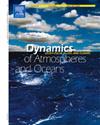Evolution of the vertically tilted structure of MJO during its eastward propagation
IF 1.9
4区 地球科学
Q2 GEOCHEMISTRY & GEOPHYSICS
引用次数: 0
Abstract
The existence and evolution of MJO vertically tilted structure (VTS) across its eastward propagation have been validated through the diagnosis of observational data during 1979–2022 boreal winter. A total of 53 eastward-propagating MJO events, comprising 215 pentads, were selected based on cluster diagnosis. By comparing the range of ascending motion between the upper and lower layers in the rear of MJO convective centers, it has been demonstrated that the VTS exists only on the intraseasonal time scale and is not presented in the high-frequency or low-frequency fields. 70 % of MJO pentads are occupied with VTS. The proportion and intensity of VTS vary as the MJO propagates eastward from 60°E to 180°, both exhibiting a bimodal distribution. In most basins, MJO with VTS is a prominent feature, except where MJO convection is just forming (60°-70°E) or about to dissipate (170°E to 180°), in which the proportion of VTS is lower than that of no-VTS. The intensity of VTS follows a similar evolutionary pattern, being strongest in the Western Pacific and weakest in the western Indian Ocean and central Pacific. There is positive (negative) relationship between phase speed and intensity of VTS (proportion of no-VTS), the correlation coefficient of which is 0.59 (-0.66), all exceeding the 99 % significant level. The evolution of VTS would be regulated by the low-frequency background. The precipitation has a prominently positive (negative) impact on the intensity of VTS (no-VTS proportions). The vertical wind shear and upper-layer zonal velocity have a significantly negative (positive) effect on the intensity of VTS (no-VTS proportions).
MJO东移过程中垂直倾斜结构的演化
通过对1979-2022年北方冬季观测资料的诊断,验证了MJO垂直倾斜结构(VTS)在其东传播过程中的存在和演变。基于聚类诊断,选取了53个向东传播的MJO事件,共215个候。通过对MJO对流中心后方高层和低层上升运动范围的比较,证明了VTS仅存在于季节内时间尺度上,而不存在于高频和低频场。70% %的MJO pentad被VTS占用。VTS的比例和强度随MJO从60°E向东传播至180°E而变化,均呈现双峰分布。除了MJO对流刚刚形成(60°~ 70°E)或即将消散(170°E ~ 180°E)的区域外,在大多数盆地中,有VTS的MJO是一个突出的特征,在这些区域中,VTS的比例低于无VTS。VTS的强度遵循类似的演化模式,在西太平洋最强,在西印度洋和太平洋中部最弱。相速度与VTS强度(无VTS比例)呈正(负)相关,相关系数为0.59(-0.66),均超过99 %的显著水平。VTS的演化将受到低频背景的调控。降水对VTS强度(无VTS比例)有显著的正(负)影响。垂直风切变和高空纬向速度对VTS强度(无VTS比例)有显著的负(正)作用。
本文章由计算机程序翻译,如有差异,请以英文原文为准。
求助全文
约1分钟内获得全文
求助全文
来源期刊

Dynamics of Atmospheres and Oceans
地学-地球化学与地球物理
CiteScore
3.10
自引率
5.90%
发文量
43
审稿时长
>12 weeks
期刊介绍:
Dynamics of Atmospheres and Oceans is an international journal for research related to the dynamical and physical processes governing atmospheres, oceans and climate.
Authors are invited to submit articles, short contributions or scholarly reviews in the following areas:
•Dynamic meteorology
•Physical oceanography
•Geophysical fluid dynamics
•Climate variability and climate change
•Atmosphere-ocean-biosphere-cryosphere interactions
•Prediction and predictability
•Scale interactions
Papers of theoretical, computational, experimental and observational investigations are invited, particularly those that explore the fundamental nature - or bring together the interdisciplinary and multidisciplinary aspects - of dynamical and physical processes at all scales. Papers that explore air-sea interactions and the coupling between atmospheres, oceans, and other components of the climate system are particularly welcome.
 求助内容:
求助内容: 应助结果提醒方式:
应助结果提醒方式:


